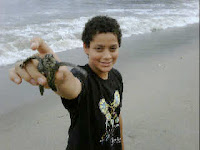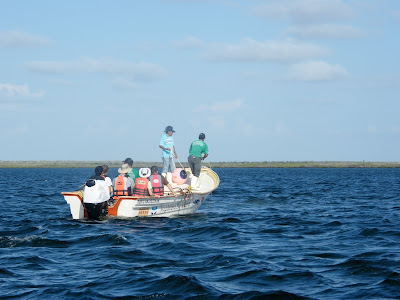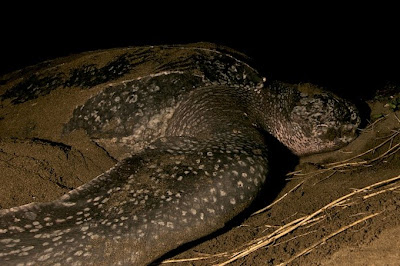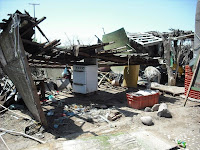Year of the Turtle (translated, Spanish follows)
Homero Aridjis
La Refora, Jun 3, 2007
A blue wind shakes my flippers, a strange tide turns on my chest, the green sea, the dark sea is calling me, the old ocean is yelling at me in the sand.
Laura Laud (leatherback), “Song of the Sea Turtle”
“The light of the sun has drowned on the horizon. The tenuous moon illuminates the earth. From the heart of the night left a sea turtle. A wave deposited her on the sand. The males had left in search of their feeding grounds. Only the females ventured to the edge to lay their eggs. A few at a time. The long beach giving to the open sea.
“And it extended kilometers and kilometers until vanishing into darkness, there in the dunes. The waves pounding the coast like white fury. In its return, they take small creatures toward the sea.” (Aridjis, The Search for Archelon. Odessy of the seven turtles.)
This fantastic spectacle, seen by human beings for millennia, is still repeated on Mexican beaches on the Pacific Ocean. But soon, if we don’t do something to conserve it, seeing a leatherback nesting in Mexiquillo, Michoacan or on the coasts of Oaxaca and Sonora, will be like catching sight of a stegosaurus grazing between plants in the Jurassic. The children of the future, you could almost say, in the second half of the 21st century, won’t be conscious of the natural wonders of those that are being lost. Only if the government and civil society work together, supported by large media outlets, and in close collaboration with communities, and ethnic groups like the Seri Indians who venerate the leatherback, can we accomplish the miracle of the leatherback not going extinct.
At the end of May of 1990, the Mexican government, under pressure from the Group of 100 and a coalition formed by national and international organizations, decreed the total prohibition of killing the seven species of turtles in Mexican waters and beaches. That way the olive ridley was protected, the most sacrificed of all in the infamous Mazunte fleamarket, and in clandestine markets that were detected only by their pools of blood that left their primitive shelters dedicated to the death of the chelonia. In a National Geographic movie about the Mexico of the past, a hidden camera filmed the moment where the turtle poachers killed the ridleys with a bullet in the head or a machete. Those captured in the high sea had their flippers cut, to later return them to the water, where they drowned and suffered long agony or attacked by sharks. In the recent arribada season, we could state, on the beaches of Escobilla and Morro Ayuta, the fruit of this decree: the massive return of the olive ridley to nest on Oaxaca’s beaches.
Just as 2006 was the Year of the Golden Eagle and 2005 was the Year of the Jaguar, both species in danger of extinction, all of us concerned about the survival of the sea turtle celebrated that this June 5th, World Environment Day, president Felipe Calderon declared 2007 the Year of the Sea Turtle. With this declaration, special attention will be called to the leatherback turtle, a specie that is very close to disappearing. If in his term president Calderon succeeds in saving the leatherback from extinction, whose population has been and is being decimated by fishing gear and coastal habitat destruction, his government will go down in history as one determined to protect one of the oldest species on earth.
With this opportune declaration, and with an Interamerican Cooperative Treaty, our country would head the environmental crusade for the shared protection of these migratory species, since Mexico has more species of sea turtles, more nesting beaches, and more places to observe them in the sea than any other country. Mexico should be the leader in the sustainable observation of the sea turtle, and in using the obtained benefits that are derived for the prosperity of local communities. If the sea turtle is one of the most important animals to Mexico, by consequence we have a responsibility to protect them and conserve them.
According to a WWF study, while 10 million people spend more than $1.25 billion dollars every year to observe whales and dolphins, less than 200,000 people frequent sites for sea turtles. The study showed that local communities can earn three times from tourism than the short-term value of consuming sea turtles and its eggs without taking into account the long-term value of the role of sea turtles on ecosystems, cultures, traditions, and economies; making the turtle a symbol of the authentic sustainability when equipping local populations with the infrastructure to receive ecotourists. Guiding the public to the “turtle towns”, one can save the turtle and transform their economy. Biologist Wallace J. Nichols, student of the oceanic migrations of the sea turtle, says that “people always tell of their experiences swimming with turtles or seeing them at night laying their eggs on the beach. For some, it changes their life.”
To finish I cite the epigraph of The Search for Archelon, whose verses express the magic of nighttime nesting of a hawksbill turtle on a beach of the Gulf of Mexico.
Today, as millions of years ago,
we arrive at the same beach.
Today, as millions of years ago,
the same mystery.
Carmen Carey (hawksbill), “Memories of the Caribbean”








 While
While 










